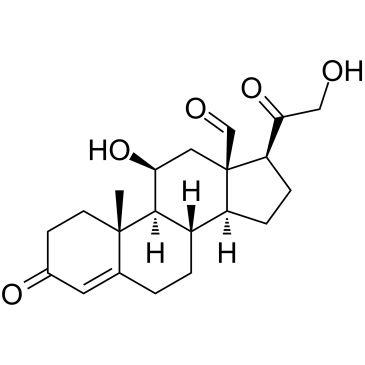aldosterone

aldosterone structure
|
Common Name | aldosterone | ||
|---|---|---|---|---|
| CAS Number | 52-39-1 | Molecular Weight | 360.444 | |
| Density | 1.3±0.1 g/cm3 | Boiling Point | 568.1±50.0 °C at 760 mmHg | |
| Molecular Formula | C21H28O5 | Melting Point | 170-172ºC | |
| MSDS | Chinese USA | Flash Point | 311.4±26.6 °C | |
| Symbol |


GHS02, GHS07 |
Signal Word | Danger | |
|
Cistrome of the aldosterone-activated mineralocorticoid receptor in human renal cells.
FASEB J. 29 , 3977-89, (2015) Aldosterone exerts its effects mainly by activating the mineralocorticoid receptor (MR), a transcription factor that regulates gene expression through complex and dynamic interactions with coregulators and transcriptional machinery, leading to fine-tuned cont... |
|
|
Finerenone Impedes Aldosterone-dependent Nuclear Import of the Mineralocorticoid Receptor and Prevents Genomic Recruitment of Steroid Receptor Coactivator-1.
J. Biol. Chem. 290 , 21876-89, (2015) Aldosterone regulates sodium homeostasis by activating the mineralocorticoid receptor (MR), a member of the nuclear receptor superfamily. Hyperaldosteronism leads todeleterious effects on the kidney, blood vessels, and heart. Although steroidal antagonists su... |
|
|
Sodium homeostasis is preserved in a global 11β-hydroxysteroid dehydrogenase type 1 knockout mouse model.
Exp. Physiol. 100 , 1362-78, (2015) What is the central question of this study? Glucocorticoids act in the kidney to promote salt and water retention. Renal 11β-hydroxysteroid dehydrogenase type 1 (11βHSD1), by increasing local concentrations of glucocorticoids, may exert an antinatriuretic eff... |
|
|
Oxidative DNA damage in kidneys and heart of hypertensive mice is prevented by blocking angiotensin II and aldosterone receptors.
PLoS ONE 9(12) , e115715, (2015) Recently, we could show that angiotensin II, the reactive peptide of the blood pressure-regulating renin-angiotensin-aldosterone-system, causes the formation of reactive oxygen species and DNA damage in kidneys and hearts of hypertensive mice. To further inve... |
|
|
Harvest and primary culture of the murine aldosterone-sensitive distal nephron.
Am. J. Physiol. Renal Physiol. 308 , F1306-15, (2015) The aldosterone-sensitive distal nephron (ASDN) exhibits axial heterogeneity in structure and function from the distal convoluted tubule to the medullary collecting duct. Ion and water transport is primarily divided between the cortex and medulla of the ASDN,... |
|
|
Tumor interstitial fluid promotes malignant phenotypes of lung cancer independently of angiogenesis.
Cancer Prev. Res. (Phila.) 8 , 1120-9, (2015) Angiogenesis is necessary for cancer progression, but antiangiogenic therapy actually promotes tumor recurrence, progression, and metastasis. This study focused on the contribution of the tumor interstitial fluid (TIF) to lung cancer progression. TIF was isol... |
|
|
A quantitiative LC-MS/MS method for the measurement of arachidonic acid, prostanoids, endocannabinoids, N-acylethanolamines and steroids in human plasma.
J. Chromatogr. B. Analyt. Technol. Biomed. Life Sci. 976-977 , 6-18, (2015) Free arachidonic acid is functionally interlinked with different lipid signaling networks including those involving prostanoid pathways, the endocannabinoid system, N-acylethanolamines, as well as steroids. A sensitive and specific LC-MS/MS method for the qua... |
|
|
Muscle transcriptome response to ACTH administration in a free-ranging marine mammal.
Physiol. Genomics 47 , 318-30, (2015) While much of our understanding of stress physiology is derived from biomedical studies, little is known about the downstream molecular consequences of adaptive stress responses in free-living animals. We examined molecular effectors of the stress hormones co... |
|
|
Evidence for aldosterone-dependent growth of renal cell carcinoma.
Int. J. Exp. Pathol. 95(4) , 244-50, (2014) The aim if this study was to investigate the hypothesis that K-RAS 4A is upregulated in a mineralocorticoid-dependent manner in renal cell carcinoma and that this supports the proliferation and survival of some renal cancers. Expression of the K-RAS in renal ... |
|
|
Regression of albuminuria and hypertension and arrest of severe renal injury by a losartan-hydrochlorothiazide association in a model of very advanced nephropathy.
PLoS ONE 8(2) , e56215, (2013) Treatments that effectively prevent chronic kidney disease (CKD) when initiated early often yield disappointing results when started at more advanced phases. We examined the long-term evolution of renal injury in the 5/6 nephrectomy model (Nx) and the effect ... |